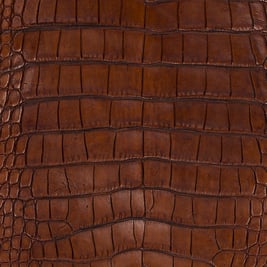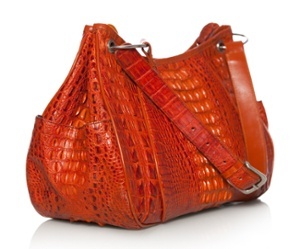
Exotic leather is an extremely valuable and attractive material for high-end fashion products. These products are often quite unique and impossible to replace if they get damaged. So, it’s important to take really good care of your alligator and crocodile skin handbags, shoes, and other products.
With this in mind, here are some exotic leather care tips for alligator and crocodile skin that you can follow to help maximize the useful life (and beauty) of your exotic goods.
Caring for Alligator Leather
American alligator skin is a rare and highly precious material. Given the value and rarity of alligator skin leather goods, it’s important to take excellent care of them to keep them looking like new for as long as possible.
Cleaning Alligator Leather
Cleaning alligator leather products can be tricky, as excessive moisture or strong chemicals can strip away the finish of a hide and ruin its appearance.
When cleaning alligator leather, be sure to avoid using water and untested chemical compounds on the hide. If the leather has excess moisture on it, be sure to gently rub the affected area with a soft, dry towel or cloth to soak up the water. Afterwards, hang-dry the item in a well-ventilated, cool area to finish.
During the drying process, be sure to keep the alligator leather well away from any heat sources, including direct sunlight. Heat stress can damage the finish and discolor the hide.
Once the leather is dry, consider applying a specially-formulated alligator leather conditioner to protect the finish from dust, dirt, and further exposure to moisture. The retailer selling the leather should be able to tell you where you can order the right conditioner for your alligator hide.
When first applying a new conditioner to any exotic leather product, be sure to test it on a small, inconspicuous area of the product first and let it sit for an hour. Spots such as the back of a boot’s tongue are ideal for this testing. This should let you see if the conditioner will alter the look of your alligator leather at all.
To remove dirt and dust, carefully wipe the alligator hide clean with a dry cloth. For finer particulates, dabbing the affected area with a damp cloth can be effective, but you’ll want to dry and retreat the hide afterwards to avoid damaging the finish.
Storing Alligator Leather
Alligator leather items should be stored in a cool, dry environment. Any storage space should be temperature-regulated to prevent prolonged exposure to any extreme conditions.
Although alligator leather is very flexible, it’s important to store any leather goods in a way that prevents severe creasing. For example, alligator leather boots should be stored with boot shapers to help keep the shaft of the boot leg from collapsing during storage.
Alligator leather handbags should be filled with light paper stuffing when not in use to keep the bags from sagging and forming crease marks. If hanging alligator skin products, use hangers that have broad, rounded contact surfaces to maximize surface contact area and reduce stress on the hide rather than thin metal wires.
Caring for Crocodile Leather
 Caring for crocodile leather is often very similar to caring for alligator leather. However, there are enough differences to warrant having a separate list of crocodile leather care tips. Please note that the following consists mostly of general advice and some leather finishes might require extra care.
Caring for crocodile leather is often very similar to caring for alligator leather. However, there are enough differences to warrant having a separate list of crocodile leather care tips. Please note that the following consists mostly of general advice and some leather finishes might require extra care.
Cleaning Crocodile Leather
To remove excess moisture, gently rub the affected area of the crocodile leather product with a soft, dry towel or cleaning cloth to soak up the majority of the excess moisture—similarly to what you would do with alligator leather. Once that is done, hang-dry the item to finish removing excess moisture. It is important to avoid using direct sunlight or any other direct heat source when drying the leather, as that may cause damage to the finish and result in discoloration or cracks.
After the leather is dry, apply leather conditioner formulated for your crocodile leather to help protect the finish and keep it looking new. When applying the crocodile leather conditioner, be sure to follow the application instructions on the conditioner’s packaging.
Leather conditioner for crocodile hide should be easy to find at any exotic leather goods retailer. However, if you are having difficulty finding the right crocodile leather conditioner for treating the specific finish of your crocodile skin, contacting the manufacturer can prove helpful for finding the right crocodile leather care products.
For removing dirt, dust, and other contaminants, the process from above remains largely the same, possibly minus the time spent drying the leather. First, remove the contaminant with a dry cloth. For fine particulates such as sand, using a slightly damp cloth to remove the dirt can make the initial cleaning process easier, but the leather will need to be dried and treated with conditioner afterward to reduce the risk of damage to the finish.
Whenever trying a new leather care product on a crocodile leather item (or any other exotic leather item), first test it on an inconspicuous part of the item first to see if it affects the finish adversely. For example, the inside sleeve or cuff of a jacket. This way, if the new product does cause some discoloration, it won’t be in a place where everyone can see it right away.
Storing Crocodile Leather
When not in use, crocodile leather items such as boots or shoes should be kept in a cool, dry environment. One example of an appropriate place to store crocodile leather boots would be in a shoe closet.
For larger crocodile leather pieces, such as jackets, avoid folding them tightly. Crocodile skin, particularly caiman skin, has calcium deposits in it that makes the skin more rigid. Folding the skin too tightly at points that were not meant to be folded can cause damage, resulting in unsightly cracks or crease marks.
Ideally, instead of trying to fold leather items and putting them in a small dresser drawer, they should be hung on a coat hanger. Crocodile leather belts should also be hung by their belt buckles to avoid causing cracks in the leather.
Tips for Transporting Your Exotic Leather Handbags (or Other Exotic Skin Products)
When wearing or transporting exotic leather handbags or other products, try to minimize their direct exposure to the sun as much as possible. Direct exposure to strong sunlight can cause the color of the hide to fade and create cracks in it.
Keeping exotic leather products in an opaque, airtight case during transit helps to not only prevent sun damage but damage from exposure to contaminants in the air, such as cigarette smoke or other chemical compounds. This helps to preserve the appearance of the hide. Any such case should be large enough to hold the handbag easily without crushing it.
Following these tips for cleaning, storing, and transporting your exotic leather products can add years to their useful life, preserving the appearance and value of your exotic leather investment. Have specific questions about caring for a specific type of exotic leather or have a crocodile skin bag with a unique finish? Contact PanAm Leathers to ask for advice on how to take care of it!



